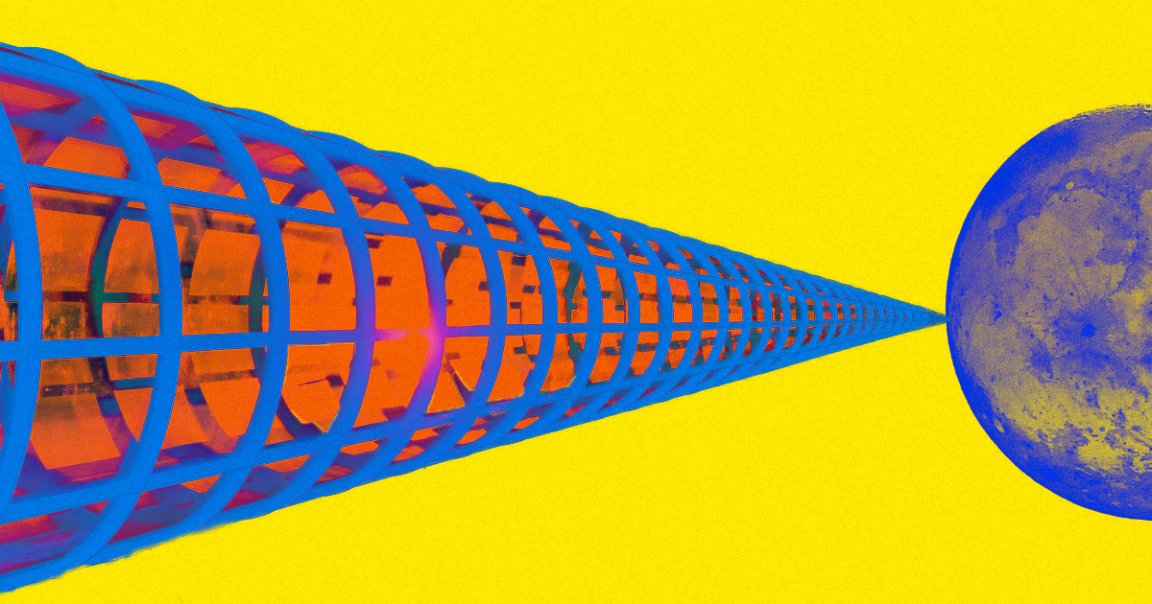
It would be much easier to escape Earth’s gravity if you could skip the energy-intensive rockets.
That’s the idea behind the Spaceline, a newly-proposed type of space elevator that would link the Earth and the Moon in a bid drastically cut the cost of space travel.
Described in research published to the preprint server ArXiv by researchers at Columbia University and Cambridge University, the Spaceline would be tethered to the surface of the Moon and dangle down into geostationary orbit around the Earth like a plumb bob, waiting for astronauts to latch on and ride into the cosmos. The proof-of-concept paper found that the Spaceline could be constructed out of materials that exist today, raising the possibility of easier space travel and perhaps even orbital settlements.
Instead of rocketing all the way out of orbit, astronauts would only need to reach the end point of the Spaceline, cutting back the cost and challenge of rocket launches. Once it reaches the vacuum of space, free of terrestrial gravity and atmospheric pressure, the spacecraft would meet up with the cable and latch onto a solar-powered shuttle that would climb along its length.
Zephyr Penoyre, one of the Columbia astronomy graduate students behind the Spaceline, told Futurism that “the line becomes a piece of infrastructure, much like an early railroad — the movement of people and supplies along it are much simpler and easier than the same journey in deep space.”
Earth-based space elevators would be too taxing for any existing material — Earth’s stronger gravitational pull and rotation speed would snap the cable before it could be completed. But the risk of a catastrophic collapse, the researchers say, is lower when the cable is only tethered to the Moon. Throughout the paper, Penoyre and Cambridge astronomy graduate student Emily Sandford often noted that carbon nanotubes would be the best material to use, but they can’t yet be built to scale.
Based on the calculations in the paper, it seems that several existing materials could be up for the challenge — it’s just a matter of finding the strongest thing that can be made at scale.
“That’s a good way to put it. Only thing to add is that it also needs to be able to survive well in deep space,” Penoyre said. “I have briefly looked into this, but am no expert in materials science. I often used Dyneema as an example material in calculations and it has some pretty good properties.”
As for the line itself, the researchers investigated a number of shapes, ultimately arriving at a cable that was extremely narrow at either end so it didn’t collapse under gravitational pressure but thickened at the middle to prevent snapping. At this stage, the astronomers didn’t factor in space debris collisions in near-Earth orbit, but Penoyre pointed out other projects that had grappled with the challenge.
If it all works out and the Spaceline someday comes to fruition, the researchers envision a future in which humanity uses it as a tether for orbital telescopes, research centers, and other facilities that could hover at the Lagrange point, the altitude at which the Moon and Earth exert equal-but-opposite gravitational force.
“Think of the early Antarctic basecamps, at first there might only be three engineers up there at any one time, but unlike low Earth orbit the Lagrange point is the perfect place to build,” said Penoyre. “We could (indulging in a little imagination) picture prefabricated panels being sent up the line, and assembled into an ever-growing colony. I was amazed to find that there are now thousands of people living a significant part of the year in Antarctica — eventually the same could be true of the Lagrange point.”
More on space elevators: Why Space Elevators Could Be the Future of Space Travel